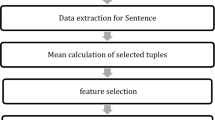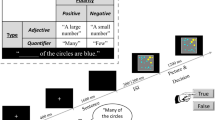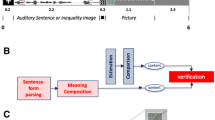Abstract
In this study, we use functional magnetic resonance imaging (fMRI) in combination with multivoxel pattern analysis to address the question of how mental activities that correspond to sentence polarity (affirmative or negative sentences) are encoded in the brain. This approach allows us to investigate the role of left/right dorsolateral prefrontal cortex (DLPFC) in predicting the neural activity of fMRI associated with sentence polarities. Subjects in the experiment were asked to judge the matching of the presented picture with the meaning of affirmative and negative sentences. Our results highlight the role of RDLPFC in encoding of the related mental activity to sentence polarities such that the right hemisphere (RDLPFC) can predict sentence polarity with high accuracy as compared to the left hemisphere (LDLPFC), and that the negative sentences are decoded with high performance as compared to affirmative sentences from the RDLPFC across subjects. In addition, this experiment’s results show that negative sentences involve more syntactic structure than affirmative sentences.






Similar content being viewed by others
References
Behroozi, M., & Daliri, M. R. (2012). Software tools for the analysis of functional magnetic resonance imaging. Basic and Clinical Neuroscience, 3, 19–20.
Behroozi, M., Daliri, M. R., & Boyaci, H. (2011). Statistical analysis methods for the fMRI data. Basic and Clinical Neuroscience, 2, 67–74.
Ben-Hur, A., & Weston, J. (2010). A user’s guide to support vector machines. Methods in Molecular Biology, 609, 223–239.
Brennan, J., & Pylkkänen, L. (2012). The time-course and spatial distribution of brain activity associated with sentence processing. Neuroimage, 60, 1139–1148.
Buckner, R. L. (1998). Event-related fMRI and the hemodynamic response. Human Brain Mapping, 6, 373–377.
Caplan, D., Alpert, N., & Waters, G. (1998). Effects of syntactic structure and propositional number on patterns of regional cerebral blood flow. Journal of Cognitive Neuroscience, 10, 541–552.
Chang, C.-C., Lin, C.-J., (2011). LIBSVM: a library for support vector machines. ACM Trans Intell Syst Technol. 2, 27:1–27:27.
Chen, Y. W., & Lin, C. J. (2006). Combining SVMs with various feature selection strategies. Feature Extraction, 207, 315–324.
Christensen, K. R. (2009). Negative and affirmative sentences increase activation in different areas in the brain. Journal of Neurolinguistics, 22, 1–17.
Cox, D. D., & Savoy, R. L. (2003). Functional magnetic resonance imaging (fMRI) “brain reading”: detecting and classifying distributed patterns of fMRI activity in human visual cortex. NeuroImage, 19, 261–270.
Daliri, M. R. (2011). Predicting the cognitive states of the subjects in functional magnetic resonance imaging signals using the combination of feature selection strategies. Brain Topography, 25, 129–135.
Daliri, M. R., & Behroozi, M. (2012). FMRI: clinical and research applications. OMICS Journal of Radiology, 01, 4.
Démonet, J.-F., & Thierry, G. (2001). Language and brain: what is up? What is coming up? Journal of Clinical and Experimental Neuropsychology, 23, 49–73.
Devroye, L., Györfi, L., & Lugosi, G. (1996). A probabilistic theory of pattern recognition. New York: Springer.
Domingos, P., & Pazzani, M. (1997). On the optimality of the simple Bayesian classifier under zero-one loss. Machine Learning, 29, 103–130.
Duda, R. O., Hart, P. E., & Stork, D. G. (2000). Pattern classification (2nd ed.). New York: Wiley-Interscience.
Eddy, W. F., Fitzgerald, M., Genovese, C., Lazar, N., Mockus, A., & Welling, J. (1999). The challenge of functional magnetic resonance imaging. Journal of Computational and Graphical Statistics, 8, 545–558.
Fiez, J. A., & Petersen, S. E. (1998). Neuroimaging studies of word reading. PNAS, 95, 914–921.
Fischl, B., van der Kouwe, A., Destrieux, C., Halgren, E., Ségonne, F., Salat, D. H., et al. (2004). Automatically parcellating the human cerebral cortex. Cerebral Cortex, 14, 11–22.
Friedland, R. P., & Iadecola, C. (1991). Roy and Sherrington (1890) A centennial reexamination of “On the Regulation of the Blood‐Supply of the Brain”. Neurology, 41, 10–10.
Friston, K. J., Rotshtein, P., Geng, J. J., Sterzer, P., & Henson, R. N. (2006). A critique of functional localisers. NeuroImage, 30, 1077–1087.
Haxby, J. V., Gobbini, M. I., Furey, M. L., Ishai, A., Schouten, J. L., & Pietrini, P. (2001). Distributed and overlapping representations of faces and objects in ventral temporal cortex. Science, 293, 2425–2430.
Huettel, S. A., Song, A. W., & McCarthy, G. (2008). Functional magnetic resonance imaging, second edition (2nd ed.). Sunderland: Sinauer Associates.
Hutchinson, R. A., Niculescu, R. S., Keller, T. A., Rustandi, I., & Mitchell, T. M. (2009). Modeling fMRI data generated by overlapping cognitive processes with unknown onsets using hidden process models. NeuroImage, 46, 87–104.
Jezzard, P., Matthews, P. M., & Smith, S. M. (Eds.). (2002). Functional MRI: An introduction to methods (1st ed.). USA: Oxford University Press.
Just, M. A., & Carpenter, P. A. (1996). Brain activation modulated by sentence comprehension. Science (New York, N.Y.), 274, 114–6.
Kamitani, Y., & Tong, F. (2005). Decoding the visual and subjective contents of the human brain. Nature Neuroscience, 8, 679–685.
Keller, T. A., Carpenter, P. A., & Just, M. A. (2001). The neural bases of sentence comprehension: a fMRI examination of syntactic and lexical processing. Cerebral Cortex, 11, 223–237.
Kuncheva, L. I., & Rodríguez, J. J. (2010). Classifier ensembles for fMRI data analysis: an experiment. Magnetic Resonance Imaging, 28, 583–593.
Lancaster, J. L., Woldorff, M. G., Parsons, L. M., Liotti, M., Freitas, C. S., Rainey, L., et al. (2000). Automated Talairach atlas labels for functional brain mapping. Human Brain Mapping, 10, 120–131.
Lemm, S., Blankertz, B., Dickhaus, T., & Müller, K. R. (2011). Introduction to machine learning for brain imaging. NeuroImage, 56, 387–399.
Manenti, R., Cappa, S. F., Rossini, P. M., & Miniussi, C. (2008). The role of the prefrontal cortex in sentence comprehension: an rTMS study. Cortex, 44, 337–344.
Martín-Loeches, M., Fernández, A., Schacht, A., Sommer, W., Casado, P., Jiménez-Ortega, L., et al. (2012). The influence of emotional words on sentence processing: electrophysiological and behavioral evidence. Neuropsychologia, 50(14), 3262–72.
Matthews, P. M., & Jezzard, P. (2004). Functional magnetic resonance imaging. Journal of Neurology, Neurosurgery, and Psychiatry, 75, 6–12.
Mitchell, T. M., Hutchinson, R., Niculescu, R. S., Pereira, F., Wang, X., Just, M., et al. (2004). Learning to decode cognitive states from brain images. Machine Learning, 57, 145–175.
Mitchell, T. M., Shinkareva, S. V., Carlson, A., Chang, K. M., Malave, V. L., Mason, R. A., et al. (2008). Predicting human brain activity associated with the meanings of nouns. Science, 320, 1191–1195.
Mourão-Miranda, J., Bokde, A. L. W., Born, C., Hampel, H., & Stetter, M. (2005). Classifying brain states and determining the discriminating activation patterns: support vector machine on functional MRI data. NeuroImage, 28, 980–995.
Ng, A. Y., Jordan, M. I., (2002). On discriminative vs. generative classifiers: a comparison of logistic regression and naive Bayes.
Poldrack, R. A. (2007). Region of interest analysis for fMRI. Social Cognitive and Affective Neuroscience, 2, 67–70.
Price, C. J. (2012). A review and synthesis of the first 20 years of PET and fMRI studies of heard speech, spoken language and reading. NeuroImage, 62, 816–847.
Rumsey, J. M., Horwitz, B., Donohue, B. C., Nace, K., Maisog, J. M., & Andreason, P. (1997). Phonological and orthographic components of word recognition. A PET-rCBF study. Brain, 120, 739–759.
Sato, Y., Mori, K., Koizumi, T., Minagawa-Kawai, Y., Tanaka, A., Ozawa, E., et al. (2011). Functional lateralization of speech processing in adults and children who stutter. Frontiers in Psychology, 2, 70.
Saxe, R., Brett, M., & Kanwisher, N. (2006). Divide and conquer: a defense of functional localizers. NeuroImage, 30, 1088–1096.
Stehman, S. V. (1997). Selecting and interpreting measures of thematic classification accuracy. Remote Sensing of Environment, 62, 77–89.
Theodoridis, S., & Koutroumbas, K. (2003). Pattern recognition, second edition (2nd ed.). Boston: Academic.
Tsoumakas, K. T. G., Kalliris, G., Vlahavas, I., (2008). Multi-label classification of music into emotions, In: ISMIR 2008: Proceedings of the 9th International Conference of Music Information Retrieval. p. 325.
Tzourio-Mazoyer, N., Landeau, B., Papathanassiou, D., Crivello, F., Etard, O., Delcroix, N., et al. (2002). Automated anatomical labeling of activations in SPM using a macroscopic anatomical parcellation of the MNI MRI single-subject brain. NeuroImage, 15, 273–289.
Vartanian, O., & Goel, V. (2005). Task constraints modulate activation in right ventral lateral prefrontal cortex. NeuroImage, 27, 927–933.
Wagner, A. D., Schacter, D. L., Rotte, M., Koutstaal, W., Maril, A., & Dale, A. M. (1998). Building memories: remembering and forgetting of verbal experiences as predicted by brain activity. Science, 281, 1188–1191.
Wandell, B. A. (2011). The neurobiological basis of seeing words. Annals of the New York Academy of Sciences, 1224, 63–80.
Acknowledgement
The authors would like to thank Prof. Tom Mitchell for providing the data for analysis. This work was funded by the Institute for Research in Fundamental Sciences (IPM), School of Cognitive Sciences.
Informed consent statement
All procedures followed were in accordance with the ethical standards of the responsible committee on human experimentation (institutional and national) and with the Helsinki Declaration of 1975, as revised in 2000. Informed consent was obtained from all patients for being included in the study.
Conflict of interest
M. Behroozi and M.R. Daliri declare that they have no conflicts of interest.
Author information
Authors and Affiliations
Corresponding author
Rights and permissions
About this article
Cite this article
Behroozi, M., Daliri, M.R. RDLPFC area of the brain encodes sentence polarity: a study using fMRI. Brain Imaging and Behavior 9, 178–189 (2015). https://doi.org/10.1007/s11682-014-9294-z
Published:
Issue Date:
DOI: https://doi.org/10.1007/s11682-014-9294-z




